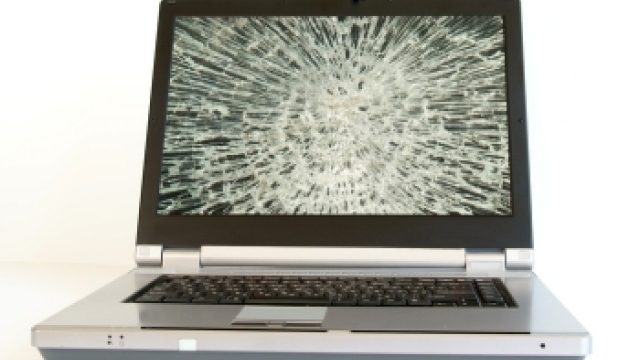If you’ve ever experienced the frustration of a cracked monitor screen, you know how disruptive it can be to your workflow or entertainment experience.
Most people assume that external accidents cause these cracks, but there’s another culprit that often goes unnoticed: internal screen cracks.
In this article, we’ll delve into the world of hidden monitor damage and provide you with essential troubleshooting tips to identify and resolve internal screen cracks.
Unseen Damage: Internal Screen Cracks
Internal screen cracks can be deceptive; they are not visible to the naked eye. Unlike external cracks that are usually apparent on the surface, internal fractures occur beneath the screen’s glass or LCD panel.
These cracks might be caused by various factors, including manufacturing defects, thermal stress, or even rough handling during shipping.
Hidden Culprits: Internal Monitor Damage
One of the main culprits behind internal screen cracks is pressure or stress applied to the monitor.
This can happen when the monitor is squeezed too tightly during packaging or when heavy objects press against it. Additionally, fluctuations in temperature can cause the monitor’s components to expand and contract, leading to tiny cracks over time.
Fixing Internal Cracks: DIY Guide
While external cracks might necessitate professional repair or a replacement, internal cracks are often challenging to address without technical expertise. However, for minor cases, you can attempt a DIY fix.
Start by turning off the monitor and unplugging it. Gently press on the areas around the crack to see if there’s any give, indicating the presence of internal damage. But be cautious not to apply excessive pressure, as this can worsen the situation.
Related Article: Why is My Laptop Screen Flashing Different Colors: Fix It
Understanding Internal Screen Fractures
To better comprehend internal screen fractures, it’s essential to understand the different types. One common type is the stress crack, which occurs due to pressure on the monitor.
Another type is the impact crack, resulting from a forceful hit to the screen. Knowing the type of internal crack can help you trace back the cause and possibly prevent future damage.
Cracked Monitor? Look Deeper Inside
If you suspect an internal crack but can’t visually confirm it, there are a few tricks to investigate further.
Try shining a flashlight at an angle onto the screen while it’s turned off. If you notice faint lines or patterns, it’s a sign of internal damage. Additionally, you can connect the monitor to a different computer or device to rule out any external display issues.
Causes of Internal Screen Breakage
Internal screen breakage can occur due to a variety of reasons. Apart from the pressure and temperature fluctuations mentioned earlier, manufacturing defects in the screen’s construction or improper handling during installation can also play a role.
Moreover, subjecting the monitor to excessive vibrations or dropping it can lead to internal cracks.
Solutions for Internal Monitor Cracks
Unfortunately, repairing internal monitor cracks is not as straightforward as fixing external ones. It’s best to reach out to a professional repair service or the manufacturer for guidance.
If the monitor is under warranty, make sure to check the terms and conditions for coverage of internal damages. Always avoid attempting to open the monitor yourself, as it can lead to further damage and void the warranty.
Related Article: Laptop Screen Has Weird Colors And Lines: Comprehensive Fix
Preventing Internal Screen Damage
Prevention is always better than cure, and the same holds true for internal screen cracks.
To safeguard your monitor, handle it with care during transportation, avoiding excessive pressure or stacking heavy objects on it. Additionally, keep the monitor in a controlled environment with stable temperatures and minimal vibrations.
Detecting Internal Screen Fractures
As discussed earlier, detecting internal screen fractures can be tricky, but it’s crucial for timely resolution.
Apart from the flashlight test, if you notice any odd lines, discoloration, or flickering on the screen, it might indicate internal damage. Pay attention to any changes in image quality or strange patterns that weren’t present before.
Inside Out: The Cracked Monitor Issue
The world of internal screen cracks is often overlooked, as most people assume the problem lies on the surface.
By shedding light on this issue, we hope to raise awareness and help users understand the importance of careful handling and regular maintenance. A cracked monitor can impact productivity and strain your eyes, so it’s vital to address the problem promptly.
Internal Cracks: An In-Depth Analysis
Internal screen cracks are a complex phenomenon that can be caused by multiple factors.
Conducting an in-depth analysis of these fractures involves understanding the materials used in the monitor’s construction, the impact of temperature fluctuations, and the stresses it experiences during its lifecycle. Only with this knowledge can manufacturers work towards creating more durable and resilient displays.
Protecting Your Monitor Internally
While there’s no foolproof way to protect your monitor from all potential damages, you can take some precautions to minimize the risk of internal cracks. Opt for high-quality monitor brands known for their durability.
Additionally, consider investing in a protective cover or case for your monitor, especially if you frequently transport it.
Signs of Internal Screen Damage
To reiterate, signs of internal screen damage may not be immediately evident. Keep an eye out for subtle changes in your monitor’s performance, such as color inaccuracies, abnormal brightness, or pixelated areas.
Regularly inspect your monitor, and if you notice anything out of the ordinary, don’t ignore it, as timely intervention can prevent further damage.
Troubleshoot Internal Monitor Breaks
In the unfortunate event of an internal monitor break, you can attempt some basic troubleshooting steps. First, disconnect all cables and power sources, then reconnect them securely.
Sometimes, loose connections can mimic internal damage symptoms. If the problem persists, consult the monitor’s user manual for specific troubleshooting guidelines or contact customer support for assistance.
FAQs About Monitor Screen Cracked Internally
Can you fix an internal screen crack?
Fixing an internal screen crack is challenging and usually requires professional intervention.
Internal cracks are not easily accessible, and DIY attempts can lead to further damage. Seek assistance from a certified technician for the best results.
Why is my monitor cracked on the inside?
Internal cracks in a monitor can occur due to various reasons, such as pressure applied to the screen, manufacturing defects, or mishandling during transportation.
Sometimes, the screen’s internal components can fail over time, leading to cracks.
How much does it cost to fix an internally cracked computer screen?
The cost of fixing an internally cracked computer screen varies depending on the device’s make and model.
It can be expensive, as it often involves replacing the entire screen assembly. Expect the cost to be a significant fraction of the device’s original price.
Is a cracked screen physical damage?
Yes, a cracked screen is a form of physical damage. It occurs when the display’s glass or internal layers are fractured due to impact or pressure.
Physical damage is not covered under warranty and usually requires out-of-pocket repair expenses.
Is it worth replacing a cracked screen?
Whether it’s worth replacing a cracked screen depends on the device’s age, value, and repair cost.
For newer, expensive devices, repairing the screen can be more cost-effective than buying a new one. However, for older or cheaper devices, replacement may not be worth it.
Do you have to replace the entire screen if you crack it?
In most cases, yes, you have to replace the entire screen if it gets cracked internally.
Unlike superficial cracks, internal damage affects the screen’s functionality, making it necessary to replace the entire assembly for proper operation.
Will a cracked computer screen get worse?
Yes, a cracked computer screen can worsen over time, especially if subjected to further stress or pressure.
Small cracks can spread and affect the display’s performance, leading to more severe issues like color distortion or complete display failure.
What is the easiest way to fix a cracked screen?
There is no easy DIY fix for a cracked screen. To ensure a proper and safe repair, it’s best to take your device to a certified technician or the manufacturer’s authorized service center. Attempting a DIY fix can further damage the screen or void the warranty.
How do you heal a cracked screen?
Unfortunately, there is no magical “healing” for a cracked screen. The only effective solution is to have it repaired or replaced by a professional technician.
Prevention is key; use screen protectors and handle your devices with care.
What does a cracked monitor look like?
A cracked monitor may display visible cracks on the screen surface, which can resemble jagged lines or patterns.
Depending on the severity, you might also notice discoloration, black spots, or areas where the screen is unresponsive to touch or display input.
What can damage a monitor?
Monitors can be damaged by various factors, including physical impact, excessive pressure on the screen, exposure to extreme temperatures or moisture, electrical surges, manufacturing defects, and mishandling during transportation or installation. Proper care and cautious usage can help prevent damage.
Final Thoughts About Monitor Screen Cracked Internally
Dealing with an internally cracked monitor screen can be frustrating and disheartening. It’s crucial to remember that attempting a DIY fix may worsen the damage or void the warranty.
Seeking professional assistance from certified technicians or authorized service centers is the safest option. While the cost of repair might be significant, it’s essential to weigh it against the device’s age, value, and the potential benefits of extended use.
Prevention is always better; use screen protectors and handle devices with care to minimize the risk of damage. Ultimately, investing in proper care and timely repairs ensures a prolonged and enjoyable experience with your monitor.


